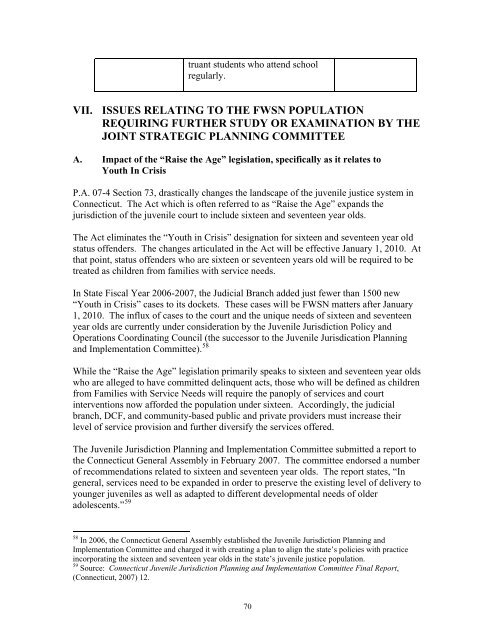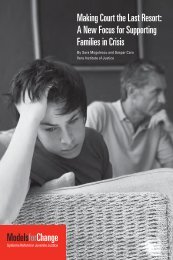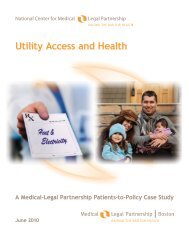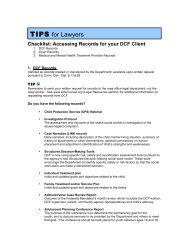FWSN-advisorybd-repo.. - The Connecticut Juvenile Justice Alliance
FWSN-advisorybd-repo.. - The Connecticut Juvenile Justice Alliance
FWSN-advisorybd-repo.. - The Connecticut Juvenile Justice Alliance
Create successful ePaper yourself
Turn your PDF publications into a flip-book with our unique Google optimized e-Paper software.
truant students who attend school<br />
regularly.<br />
VII. ISSUES RELATING TO THE <strong>FWSN</strong> POPULATION<br />
REQUIRING FURTHER STUDY OR EXAMINATION BY THE<br />
JOINT STRATEGIC PLANNING COMMITTEE<br />
A. Impact of the “Raise the Age” legislation, specifically as it relates to<br />
Youth In Crisis<br />
P.A. 07-4 Section 73, drastically changes the landscape of the juvenile justice system in<br />
<strong>Connecticut</strong>. <strong>The</strong> Act which is often referred to as “Raise the Age” expands the<br />
jurisdiction of the juvenile court to include sixteen and seventeen year olds.<br />
<strong>The</strong> Act eliminates the “Youth in Crisis” designation for sixteen and seventeen year old<br />
status offenders. <strong>The</strong> changes articulated in the Act will be effective January 1, 2010. At<br />
that point, status offenders who are sixteen or seventeen years old will be required to be<br />
treated as children from families with service needs.<br />
In State Fiscal Year 2006-2007, the Judicial Branch added just fewer than 1500 new<br />
“Youth in Crisis” cases to its dockets. <strong>The</strong>se cases will be <strong>FWSN</strong> matters after January<br />
1, 2010. <strong>The</strong> influx of cases to the court and the unique needs of sixteen and seventeen<br />
year olds are currently under consideration by the <strong>Juvenile</strong> Jurisdiction Policy and<br />
Operations Coordinating Council (the successor to the <strong>Juvenile</strong> Jurisdication Planning<br />
and Implementation Committee). 58<br />
While the “Raise the Age” legislation primarily speaks to sixteen and seventeen year olds<br />
who are alleged to have committed delinquent acts, those who will be defined as children<br />
from Families with Service Needs will require the panoply of services and court<br />
interventions now afforded the population under sixteen. Accordingly, the judicial<br />
branch, DCF, and community-based public and private providers must increase their<br />
level of service provision and further diversify the services offered.<br />
<strong>The</strong> <strong>Juvenile</strong> Jurisdiction Planning and Implementation Committee submitted a <strong>repo</strong>rt to<br />
the <strong>Connecticut</strong> General Assembly in February 2007. <strong>The</strong> committee endorsed a number<br />
of recommendations related to sixteen and seventeen year olds. <strong>The</strong> <strong>repo</strong>rt states, “In<br />
general, services need to be expanded in order to preserve the existing level of delivery to<br />
younger juveniles as well as adapted to different developmental needs of older<br />
adolescents.” 59<br />
58 In 2006, the <strong>Connecticut</strong> General Assembly established the <strong>Juvenile</strong> Jurisdiction Planning and<br />
Implementation Committee and charged it with creating a plan to align the state’s policies with practice<br />
incorporating the sixteen and seventeen year olds in the state’s juvenile justice population.<br />
59 Source: <strong>Connecticut</strong> <strong>Juvenile</strong> Jurisdiction Planning and Implementation Committee Final Report,<br />
(<strong>Connecticut</strong>, 2007) 12.<br />
70
















